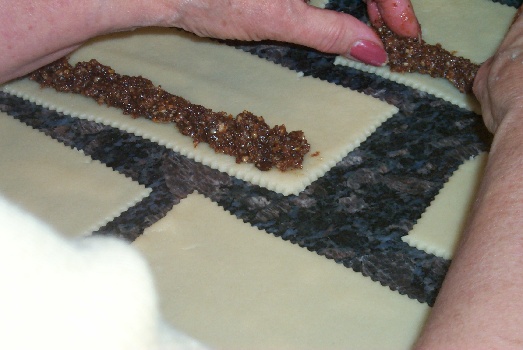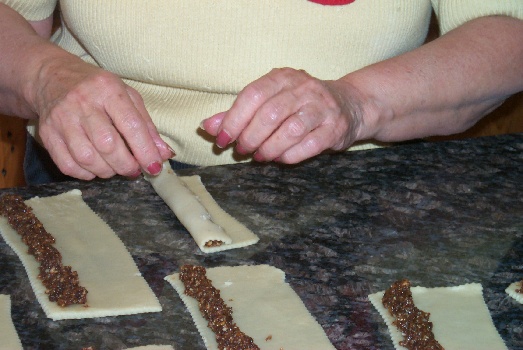We made about 60 large Cassateddi from this recipe. First we prepared the filling (conza) in a food processor. The key here is to get the correct consistency - not too dry yet not wet enough so that the conza oozes out during baking. Note the before and after photo below. The conza is predominantly raisins so it is a misnomer to call them fig cookies. From now on call all fig cookies Cassateddi and that way you can work in a story about Ustica!
| FILLING (CONZA) |
|---|
| 1 1/2 | lbs | dark raisins (2 containers) soak them in water or orang juice for several minutes and then drain off the liquid before preparing the filling. The liquid can be used to moisten the conza, if needed.
| 3/4 | lb | sliced blanched (no skin) almonds
| 1/2 | lb | dried pineapple
| 1/2 | lb | semi-sweet chocolate chips (preferrably Ghiriadelli or Guittard, not the waxy common type)
| 1/4 | lb | candied lemon rind
| 1/4 | lb | candied orange rind
| 1/4 | lb | dried black mission figs
| 3/4 | cup | orange marmalade
| 1/2 | cup | sugar
| 1/2 | cup | grand marnier liquer (or quantreau or amaretto)
| 1 | tsp | cinnamon
| 1 | tsp | vanilla or almond extract
| 1 | | fresh rind of an orange. Ours were torn by hand into small bits but many prefer to zest the rind so none of the white pith is included.
|
With all of these ingredients, I'm sure you can see how variations and substitutions are easily made. This is no exact science.
| | | | | | | | | | | | | |
|

|
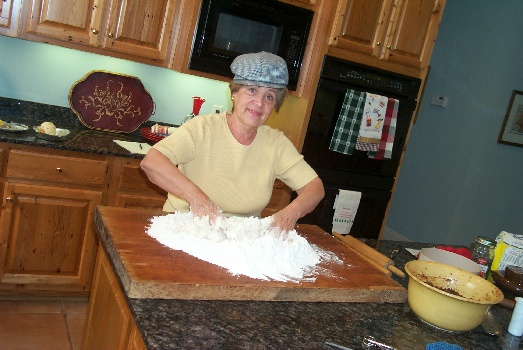
|
Now you can see why the scanatura is so important. No mixing in bowls needed. Just pour the flour out and begin kneading in the shortening. Dissolve the sugar into the wine and warm water. Work all of the flour into the shortening and then add half of the liquid while the mixture is still crumbly. Keep adding small amounts of the liquid while kneading until you get a soft consistent texture to the dough - no crumbling.
The dough is essentially a pie crust with a twist.
| 4 1/2 | lbs | flour (preferably gold-medal unbleached)
| 1 1/2 | lbs | crisco shortening
| 1 1/2 | cups | sugar
| 3/4 | cup | white wine
| 3/4 | | warm water
| | | | |
|
Now take a small 3 inch chunk of dough and roll it thin using the caneddo. We made ours about 1/8 inch thick. Many cooks prefer a much thinner crust so that the thickness of the finished Cassateddi is 3/4 inch. The cut outs will be rectangular so be efficient and shape the dough accordingly. Our cut outs were about 3 by 6 inches. You'll need that zig-zag tool, also called a pinwheel cutter or pastry wheel (the Italian name is tonniarolo), to get the proper edge. The edge is important so don't think about cutting a straight line or you will insult the Cassateddi! If your dough was properly kneaded, the cut outs should peel up easily off of the scanatura.
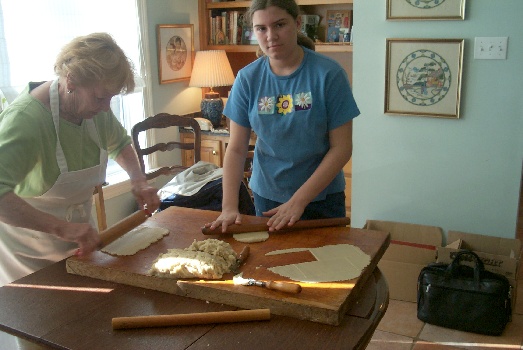
| 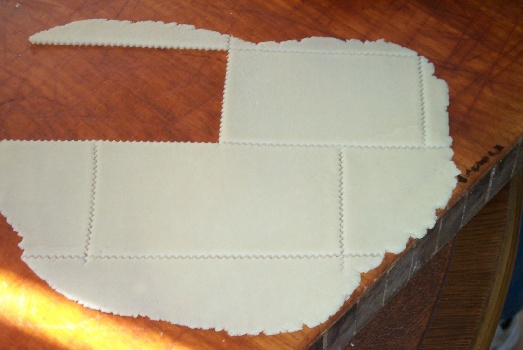
|
Now begin molding the conza on to the cut outs. Another great idea is to fill an icing bag with the conza. Don't attach a decorating tip so that the opening at the narrow end of the bag is about 3/8". This perfect for making an even and consistent line of conza ... AND no messy hands! After filling, roll them back and forth with a little pressure to seal in the filling.
|
Now gently bend the Cassateddi into a horse shoe shape and place on a baking tray. You can gease the tray for the first batch if you are concerned about the Cassateddi sticking to the tray. S-shapes are also used. With a pair of small scissors (nail clipper type) snip the dough along the entire length of the Cassateddi to create the distinctive pattern. If you see filling then you're snipping to deep.
|

|

|
Place in a an oven pre-heated to 400 degrees. It can be difficult to tell when the Cassateddi are done because you don't want the dough to brown too visibly. Maria lifted a Cassateddi and checked the bottom for brownness. If the bottom is real brown then they are done. The bottoms will be much browner than the surface. It generally takes between 20 and 25 minutes. When done, let them cool a bit and then sift some powdered sugar on top with a flour sifter or a sieve.




